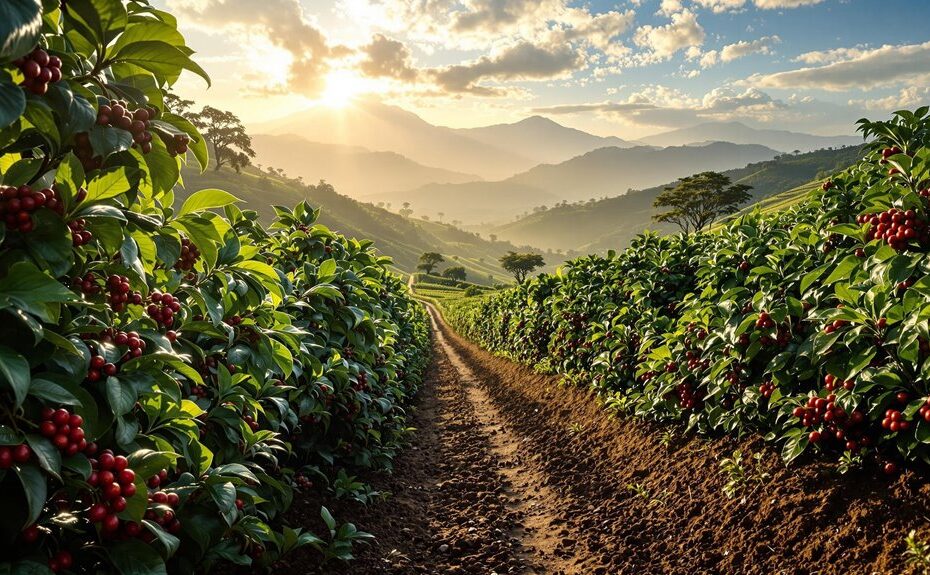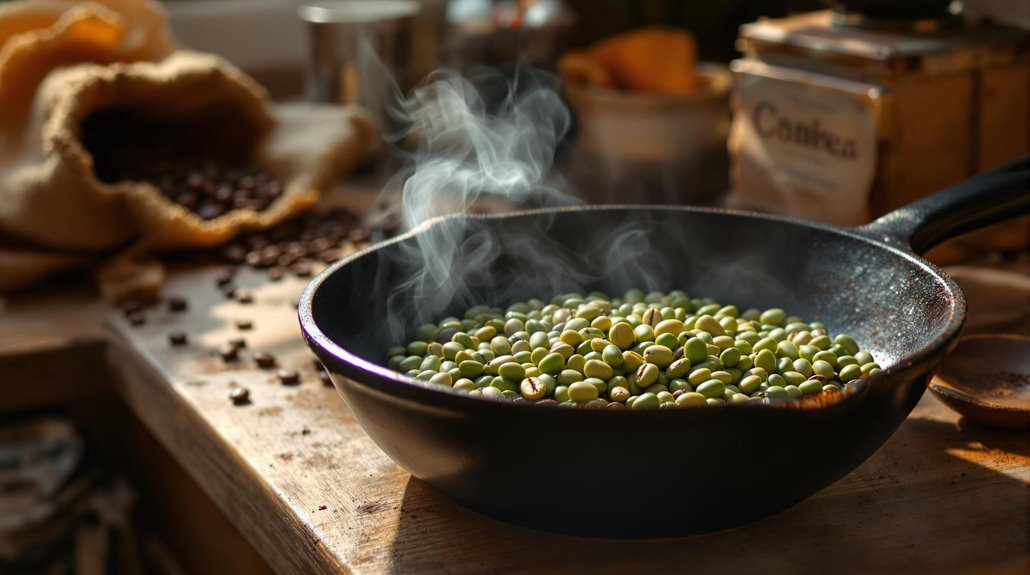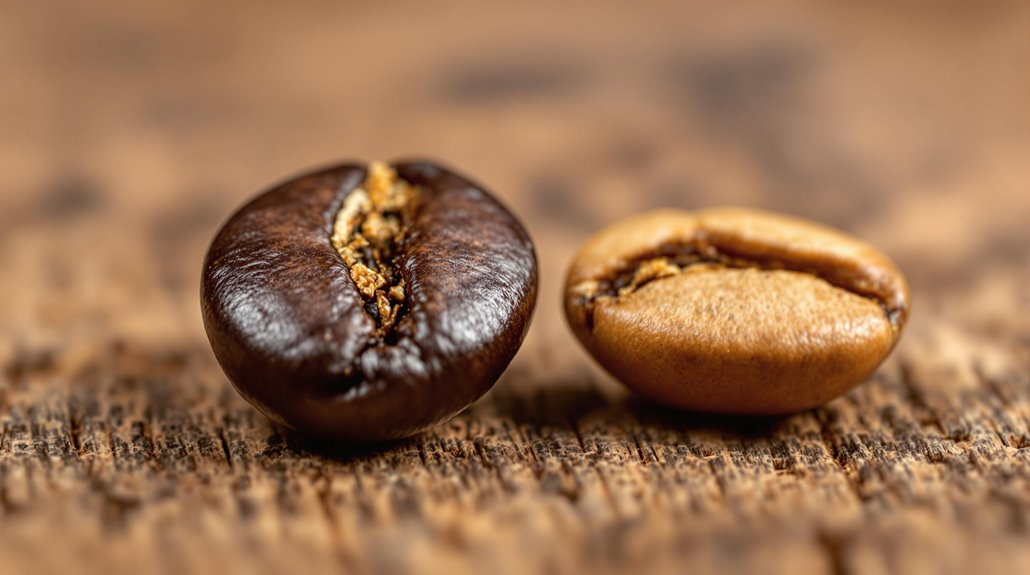







You might sip coffee daily, but do you know where those beans come from? They're grown in a narrow band around the globe called the Coffee Belt, stretching across five continents and over 70 countries. From Brazil's vast plantations to Ethiopia's high-altitude farms, each region brings unique flavors shaped by its climate and soil. Yet, not all areas within this belt produce equally—some dominate global markets, while others craft rare, sought-after varieties. What makes these regions so special, and how do their differences shape your morning cup? The answers might surprise you.
Key Takeaways
- Coffee beans are primarily grown in the Coffee Belt, spanning 25°N to 30°S across over 70 countries in tropical regions.
- South America dominates global coffee production, with Brazil, Colombia, and Peru as top producers of Arabica beans.
- Central American countries like Guatemala, Costa Rica, and Honduras grow high-quality Arabica beans with diverse flavor profiles.
- Africa, particularly Ethiopia and Kenya, is renowned for its unique, full-bodied Arabica and Robusta coffee varieties.
- North America and the Caribbean, including Hawaii and Mexico, produce limited but distinctive Arabica beans with regional flavors.
The Coffee Belt: Key Growing Regions
It's widely recognized that the Coffee Belt, spanning between 25 degrees north and 30 degrees south of the equator, serves as the primary global hub for coffee cultivation. This region, often referred to as the Bean Belt, encompasses over 70 countries across five continents, including South America, Africa, Asia, and Oceania. Coffee plants thrive here due to the consistent tropical climate, fertile volcanic soils, and distinct wet and dry seasons that are essential for ideal growth. Within this zone, you'll find major coffee-producing nations like Brazil, Ethiopia, Vietnam, and Indonesia, which collectively dominate global coffee production. Nearly all arabica coffee is grown within the Bean Belt, as the conditions between 25 degrees North and 30 degrees South provide the perfect balance of temperature, rainfall, and altitude. The region's microclimates further enhance the diversity of coffee flavors, with variations in elevation and soil composition influencing the final cup profile. By focusing on this equatorial band, you'll understand why the Bean Belt remains the epicenter of coffee cultivation, supporting both smallholder farms and large-scale plantations worldwide.
North America and the Caribbean Coffee Origins
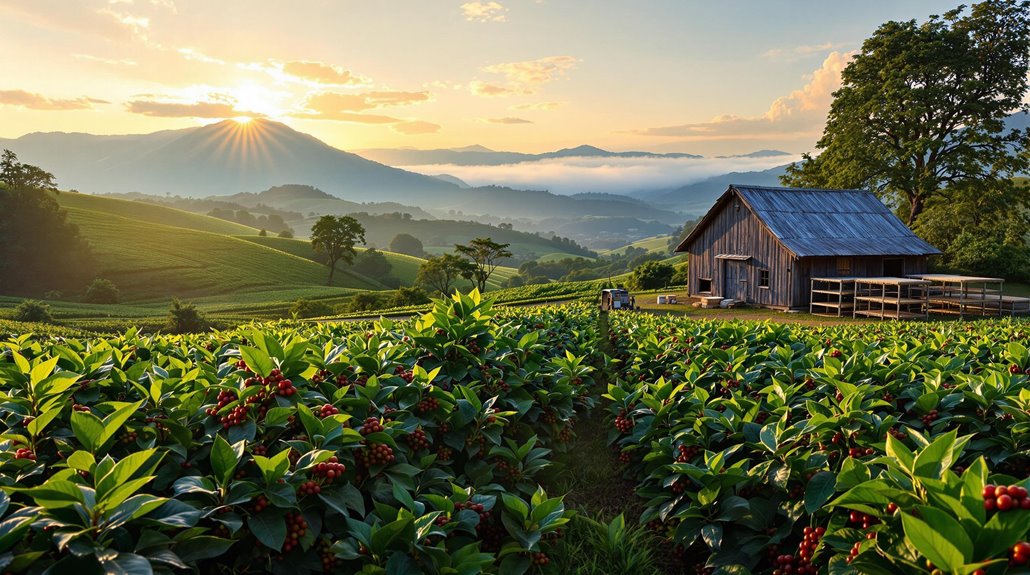
North America and the Caribbean, though not as prominent as other regions within the Coffee Belt, host unique coffee-growing areas that contribute distinct flavors and profiles to the global market. Situated between the Tropic of Cancer at 23.5 degrees North and 30 degrees North, these regions benefit from microclimates and volcanic soils ideal for coffee producing. In the United States, Hawaii stands out as the primary coffee-growing region, with Kona coffee beans cultivated on the slopes of Mauna Loa. In 2022–23, Hawaii produced 11.5 million pounds of coffee, renowned for its smooth, medium-bodied profile with nutty and fruity notes. Mexico, a significant player in Central and South coffee production, grows Arabica varieties like Altura in high-altitude regions such as Veracruz, Oaxaca, and Chiapas. These beans, often used for dark roasts, contribute substantially to Mexico's coffee exports. Puerto Rico, though smaller in scale, is reviving its coffee industry with Arabica varieties like Grand Lares and Yauco Selecto, celebrated for their balanced body and fruity aroma. These regions, though limited in output, offer unique coffee beans that reflect their terroir and climatic conditions.
Central America's Coffee-Producing Nations
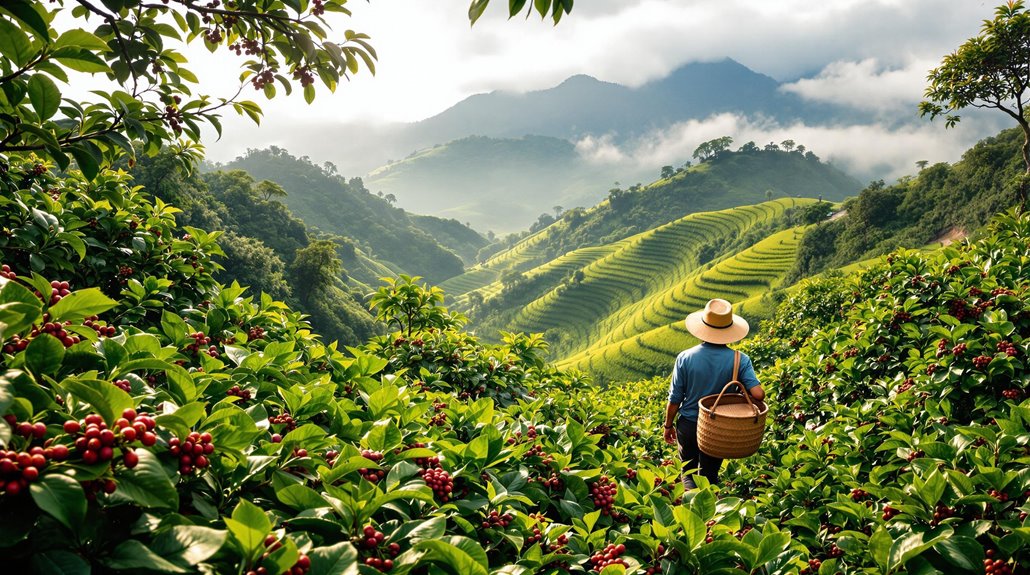
Central America's coffee-producing nations are renowned for their diverse and high-quality Arabica beans, cultivated in regions with distinct microclimates and volcanic soils. In Guatemala, coffee plantations thrive in areas like Antigua, Coban, and Huehuetenango, where volcanic soil contributes to medium-to-full-bodied beans with spicy or chocolatey notes. Costa Rica exclusively grows wet-processed Arabica varieties, ensuring a medium body, sharp acidity, and consistent quality due to advanced processing methods. Honduras stands out as a major player in Central American coffee production, with beans grown across its varied terrain, offering a balanced flavor profile and medium acidity. El Salvador's volcanic highlands yield beans with a mild, sweet flavor and bright acidity, reflecting the region's unique terroir. Nicaragua's coffee plantations, particularly in Jinotega and Matagalpa, produce beans with a medium body, fruity undertones, and a smooth finish. These nations collectively contribute to Central America's reputation for producing some of the world's finest Arabica beans, distinct from South American coffee production in both flavor profiles and cultivation practices.
South America's Dominance in Coffee Production
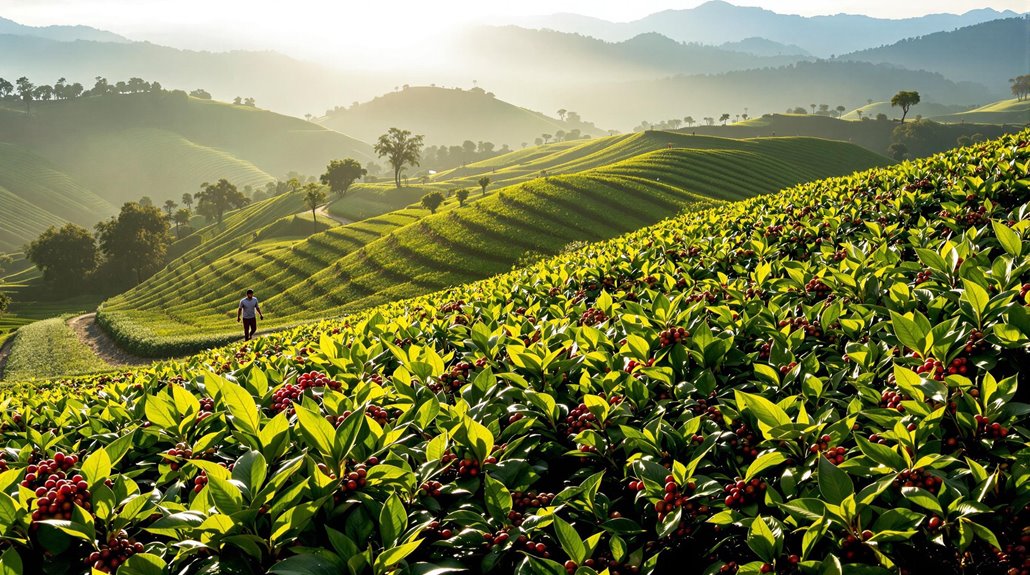
You'll find Brazil dominates global coffee production, accounting for 29% of the world's output in 2022, with its Arabica and Robusta varieties thriving in expansive plantations. Colombia, the second-largest producer, is celebrated for its high-quality Arabica beans, particularly the Supremo grade, which benefits from the region's mountainous terrain and careful handling. South America's tropical climates, high altitudes, and fertile soils create ideal conditions for coffee cultivation, solidifying its position as a global leader.
Brazil's Leading Coffee Output
While South America dominates global coffee production, Brazil stands out as the undisputed leader, producing 29% of the world's coffee in 2022. As the world's largest coffee producer, Brazil harvested approximately 3.26 million metric tons of coffee that year, solidifying its position as the top coffee-producing country in the world. The South American nation's ideal climate and fertile soil, particularly in regions like Minas Gerais, São Paulo, and Espírito Santo, create ideal conditions for cultivating both Arabica and Robusta varieties. Arabica accounts for about 70% of Brazil's total coffee output, while Robusta makes up the remainder. Brazilian coffee is renowned for its clear, sweet, medium-bodied flavor and low acidity, making it a staple in global coffee blends and espresso. The country's extensive coffee plantations and advanced agricultural practices enable it to maintain its dominance in the global coffee market. By consistently producing high volumes of harvested coffee, Brazil guarantees its pivotal role in meeting worldwide demand, further cementing its status as the cornerstone of South America's coffee industry.
Colombia's High-Quality Arabica
How does Colombia maintain its reputation as a global leader in high-quality Arabica coffee? Colombia's coffee production thrives due to its unique geography, with the Andes Mountains providing ideal altitudes of 1,200 to 2,000 meters and volcanic soil enhancing bean quality. These conditions yield Arabica beans with mild acidity, aromatic sweetness, and a balanced flavor profile, making Colombian Supremo—the highest grade—a global favorite. The country produces 12-16% of the world's Arabica coffee, solidifying its position as the second-largest coffee producer globally. Regions like Antioquia, Huila, and Tolima are key contributors, leveraging their microclimates to cultivate specialty-grade beans. Colombia's coffee industry is also deeply rooted in its smallholder farmers, with over 500,000 families managing small plots. These farmers employ traditional, labor-intensive methods, ensuring meticulous care during cultivation and harvesting. The result is a consistent supply of high-quality Arabica beans, generating approximately $2.5 billion annually from exports. By combining ideal growing conditions, skilled smallholder farmers, and a focus on quality, Colombia sustains its dominance in the global Arabica coffee market.
Regional Climate Impact Analysis
South America consistently dominates global coffee production, primarily due to its unparalleled climatic conditions that favor coffee cultivation. Coffee beans grow best in regions with temperatures between 15–24°C, a range consistently maintained across South America's coffee belt. This region, spanning Brazil, Colombia, and Peru, benefits from a tropical climate characterized by distinct wet and dry seasons, ensuring ideal growth cycles. Brazil alone accounts for 29% of global coffee production, with its vast plantations in Minas Gerais and São Paulo thriving in well-drained, fertile soils. Colombia, the second-largest producer, leverages high-altitude regions and volcanic soil, which enhance the mild, balanced flavors of its Arabica beans. The combination of consistent rainfall, moderate temperatures, and advanced farming techniques enables South America to produce over 50% of the world's coffee. These climatic advantages, coupled with the region's ability to support year-round cultivation, solidify its position as the global leader in coffee production. Understanding these factors highlights why South America's climate is integral to the quality and quantity of coffee beans it produces.
East and West Africa's Coffee Heritage

East and West Africa's coffee heritage is deeply rooted in the region's diverse climates, altitudes, and cultivation practices, shaping some of the world's most distinctive coffee profiles. Ethiopian coffee, originating from the birthplace of coffee, showcases wild, full-bodied beans from regions like Sidamo, Harrar, and Kaffa, often processed using traditional wet methods. Kenyan coffee, grown at high altitudes, is celebrated for its sharp, fruity acidity and full body, with AA and AA+ graded beans commanding premium prices globally. In East Africa, the combination of volcanic soils and elevations above 1,500 meters enhances flavor complexity, making these beans highly sought after. Meanwhile, West Africa, particularly the Ivory Coast, dominates Robusta coffee production. Robusta beans thrive in lower altitudes and are prized for their bold, strong flavors, making them ideal for dark roasts and espresso blends. The Ivory Coast's focus on Robusta coffee underscores its resilience and suitability for blending, contributing substantially to global coffee supply chains. Together, these regions highlight Africa's pivotal role in shaping coffee's global diversity and quality.
Asia's Role in Global Coffee Cultivation
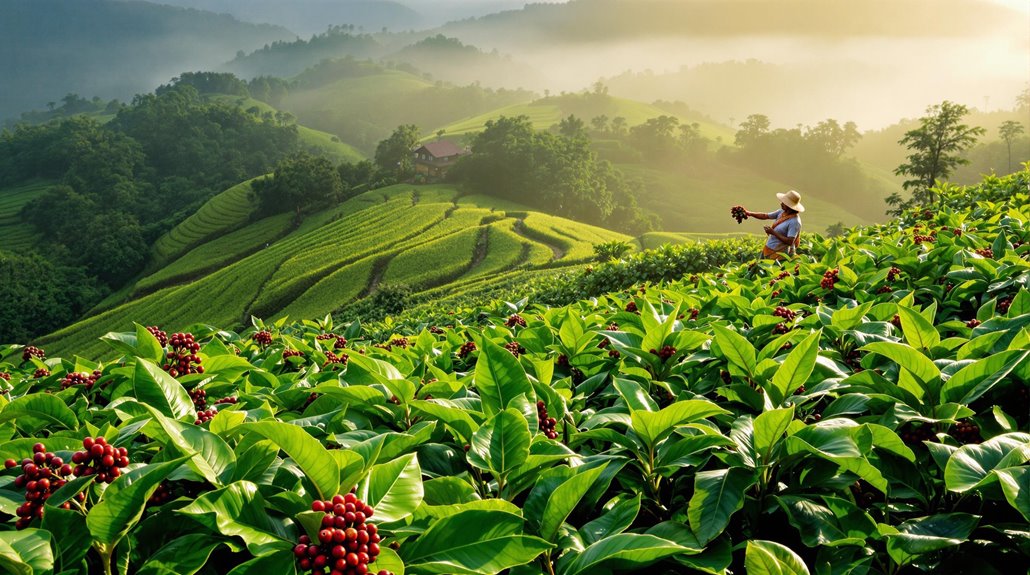
Asia stands as a cornerstone of global coffee production, with Vietnam and Indonesia leading the region's output. Vietnam ranks as the world's second-largest coffee producer, contributing 18% of global coffee production in 2022, primarily through its cultivation of Robusta beans. These beans thrive in Vietnam's warm, humid climate and are prized for their strong, bold flavor, making them a staple in international coffee blends. Indonesia, another key player, accounts for 7% of global coffee production, with regions like Sumatra, Java, and Sulawesi producing distinctive, full-bodied coffees. Traditional processing methods in Indonesia, particularly in Sumatra, preserve unique flavor profiles that modern techniques often fail to replicate. Together, Vietnam and Indonesia dominate Asia's coffee output, with Vietnam focusing on Robusta and Indonesia excelling in both Arabica and specialty coffees. Their combined contributions guarantee Asia's pivotal role in global coffee supply chains, meeting demand for both mass-market blends and premium varieties. By leveraging their climatic advantages and traditional practices, these nations sustain Asia's reputation as an essential hub in global coffee production.
Disclosure: As an Amazon Associate, I earn from qualifying purchases.
